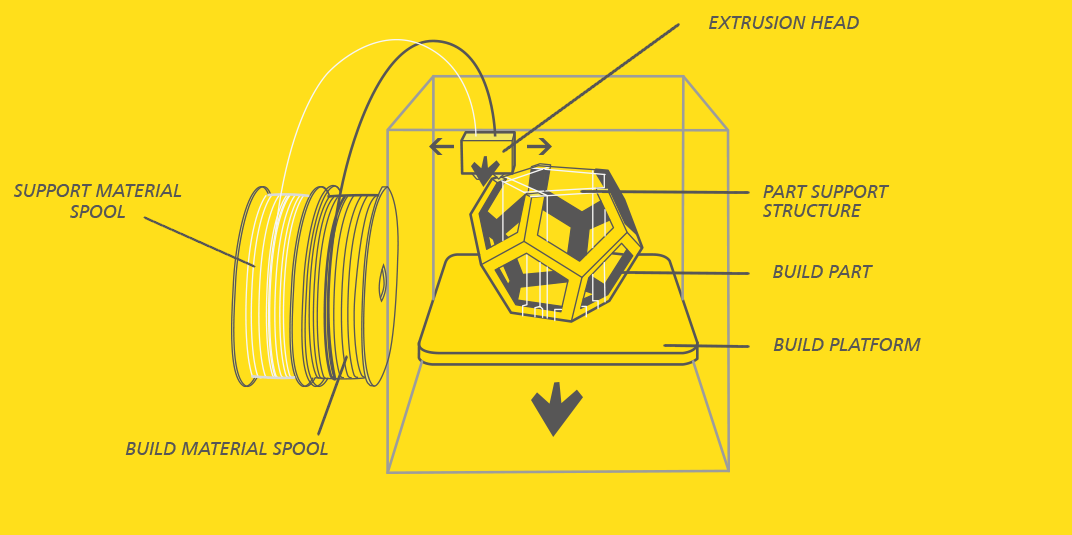
FROM HAMBURGERS TO HOUSES
How is 3D Printing Possible?
Equipment needed
Industrial machines, such as those used by GE, cost upward of $500,000 (approximately £335,000) apiece.

Six years ago, the average home 3D printer cost £20,000, some well above £60,000. Today, one can get a 3D printer for around £1000.
Companies such as RepRap produce free, open-source 3D printers for consumer use.

RepRap machines can print their own replacement parts, and the plans for RepRaps are open-source and free, meaning an owner of a RepRap can print another RepRap.
BY 2016

US 3D printing experts predict a growth of $3.1 billion in 3D printing by 2016, with the UK placing as the fifth largest country for 3D printer usage.
Sustainability

Currently, mass-produced parts made with injection molding are made much faster than 3D printed parts... a few seconds as compared to hours or as much as a day.
Additive manufacturing raw materials produce less waste, weigh less, and are less costly to produce and transport than traditional manufacturing methods.
3D printing is currently cheaper and faster on a small scale, but more expensive and slower on a large scale. For example:
5000 x ![]() = 121 DAYS (3D printing $1.03/£0.67 per part)
= 121 DAYS (3D printing $1.03/£0.67 per part)
VS
15 DAYS (Traditional injection moulding and only $0.85/£0.55 per part)

There isn’t much hard data yet on how 3D-printed products compare to traditionally manufactured ones in terms of energy use, transportation costs, pollution and other potential environmental impacts over their lifetime.

Much of the current 3D printing stock is currently reliant on non-recycled plastic. Organizations like the Michigan Technological University's Open Sustainability Technology research group has found that using materials like recycled milk jugs for printing stock takes only 1/10th the energy required to make commercial filament.

The Dutch canal house project is undergoing study and testing to find “green” materials for its construction. They plan to construct the building with a filament made of 80% vegetable oil.
Italian designer Massimo Moretti is developing a printer that will create a sustainable house from powdered earth.
3D printed construction is still only as sustainable as the raw materials used in construction, and more studies into the long-term sustainability must still be done.
Timeline of 3D Printing

The first SLA (stereolithographic apparatus) is produced by 3D Systems.
The machine can produce complex machine parts overnight.
The first lab-grown organ, created with a 3D-printed synthetic scaffold, is implanted in a human.

Scientists at the Wake Forest Institute 3D print working kidney tissue.

RepRap, the open-source 3D printer company, is founded.

Laser sintering (SLS) machines enter use in the industrial sector.


The first self-replicating printer is released by RepRap.

Engineers at University of Southampton design and fly the first 3D-printed aircraft.
Kor Ecologic unveils Urbee, a prototype 3D-printed car.


National Additive Manufacturing Innovation Institute in Ohio is awarded $30 million from President Obama.

Defense Distributed create the first 3D printed gun called the “Liberator.” The 3D printable files were initially made public but were removed at the request of the United States Department of State.

Dutch architects start construction on a 3D printed canal house.

Chinese company WinSun construct first 3D printed villa and tallest apartment building.
sources
3Dprinting.com – What is 3D printing
3D printer.net– free 3D models
3D printer.net - 3D printing to make jet engines lighter, more efficient
Bbc.co.uk - Nokia backs 3D printing for mobile phone cases
Bbc.co.uk - Inverness girl Hayley Fraser gets 3D-printed hand
Bloomberg.com - A Guide to All the Food That's Fit to 3D Print (So Far)
Cfr.org - 3D Printing: Challenges and Opportunities for International Relations
Createitreal.com - 3D printing process
Edie.net - 3D printing and sustainability: the jury is out
Efunda.com - Rapid prototyping
Ehow.com - How does 3D printing work?
Find3dprinter.com - 3D printing in movies
Firstamericanplastic.com - 10 3D printing statistics
Forbes.com - Custom Eyewear: The Next Focal Point For 3D Printing?
Ge.com - Additive manufacturing
Iflscience.com - 3D-Printed Heart Helps Save A Newborn Baby's Life
Mashable.com - 3D-Printed Foot Lets Crippled Duck Walk Again
Nydailynews.com - Chinese company uses 3D printers to build houses, mansions
Theengineer.co.uk - The rise of additive manufacturing
Wikipedia.com - 3D printing
archdaily.com - Why 3D Printing Is Not As Sustainable As Its Defenders Say
3dprinting.com - WinSun 3D Printed Giant Apartment Building and Villa
3dprinting.com - Future Talk: 3D Printing An Entire House In Only 20 Hours
3dprinting.com - This 3D Printed Column Can Withstand an Earthquake
3dprinting.com - Architects Create Artistic Room Using a 3D Printer
3Dprinthq.com - 3D Printer Prices are Lowering
Ce.org – The History of 3D printing
blog.odysen.com - 10 Interesting facts about 3D Printing
earthisland.org - Can We 3D Print our Way to Sustainability?
ecomagination.com - A Sustainability Scorecard for 3D Printing
greenbuildingelements.com - Introducing the 3D Printed Sustainable Home
industrialmold.com - Injection Molding vs. 3D Printing
Inhabitat.com - 12,000-square-foot 3D-printed mansion pops up in China
Inhabitat.com - UC Berkeley unveils 3D-printed "Bloom" building made of powdered cement
Inhabitat.com World’s First 3D-Printed House is Being Built In Amsterdam
Inhabitat.com SketchUp's Open-Source 3D-Printable WikiHouse Snaps Together Like Lego Bricks
nydailynews.com - Dutch architect to build house with 3D printer
Thefarsightlens.com - Manufacturing : 3D Printing Versus Injection Molding
trowe.com - A brief history of 3D printing
Reprap.org - RepRap
Redorbit.com - The History of 3D Printing - https://bit.ly/1lJW7Zo
Theguardian.com - 3D-printed cities: is this the future? https://bit.ly/1FYs4KB




















share